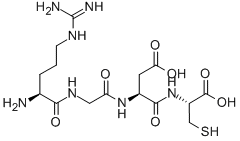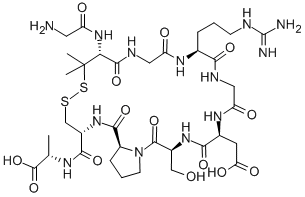ARG-GLY-ASP-SER
Synonym(s):Fibronectin Inhibitor, RGDS;H-Arg-Gly-Asp-Ser-OH - CAS 91037-65-9 - Calbiochem
- CAS NO.:91037-65-9
- Empirical Formula: C15H27N7O8
- Molecular Weight: 433.42
- MDL number: MFCD00076452
- EINECS: 1592732-453-0
- SAFETY DATA SHEET (SDS)
- Update Date: 2024-07-02 08:55:39

What is ARG-GLY-ASP-SER?
The Uses of ARG-GLY-ASP-SER
Arg-Gly-Asp-Ser has been used:
- to study its effects on cell attachment in rats
- to analyse the interaction of fibrinogen with erythrocytes occurs through integrin related receptor
- to pretreat the cells, to assess the role of integrin in the cell attachment process
- to test its competition with platelet-secreted, nanosheet-adsorbed proteins for binding to glycoprotein IIIa (GPIIIa)
The Uses of ARG-GLY-ASP-SER
Supports fibroblast attachment
What are the applications of Application
Fibronectin Inhibitor is a tetrapeptide that supports fibroblast attachment and inhibits fibronectin binding
General Description
The tetrapeptide Arg-Gly-Asp-Ser (RGDS) is a key component of the cell attachment domain of fibronectin. The RGDS sequence was found initially to promote the attachment of rat kidney fibroblasts (NRKcells) to fibronectin and synthetic fibronectin peptides coupled to protein-coated plastic. Further investigation indicated that the free RGDS peptide inhibited the attachment of NRK cells to fibronectin coated substrates. The RGDS sequence has been shown to occur in several other proteins, such as the λ receptor on E. coli and the Sindbis coat protein. RGDS is also a target sequence for spirochete adherence of the syphilis bacterium Treponema pallidum.
RGDS has been shown to block fibrinogen-induced aggregation of intact erythrocytes and specific binding of fibrinogen to erythrocyte membranes. The effect of RGDS on transforming growth factor ?1 (TGF?1) mRNA expression and secretion in cultured human mesangial cells has been investigated. RGDS has been utilized in a study of integrin-mediated signal transduction in cultured cells from the sponge Suberites domuncula. RGDS has been demonstrated
to mitigate the binding of Mycobacterium tuberculosis to murine alveolar macrophages
Biological Activity
rgds peptide contains the rgd motif which is an antagonist of integrin [1, 2].integrins are cell-surface receptors that recognize rgd motifs present in various extracellular matrix proteins such as fibronectin, vitronectin, laminin, fibrinogen, von willebrand factor, osteopontin, thrombospondin, and collagen as well as in disintegrins. integrins activation triggers different signals regulating cell adhesion, migration, survival, apoptosis as well as processes such as angiogenesis, thrombosis and osteoporosis [1].in sk-mel-110 cells, rgds at 500 μg/ml significantly inhibited melanoma cells proliferation induced by human fibroblast growth factor-2 (fgf-2). furthermore, rgds treatment (48 h, 500 μg/ml) increased the percentage of cells in sub-g1-phase from 3% (with fgf-2 alone) to 13.2% (with fgf-2 and rgds), indicating that rgds might induce apoptosis in melanoma cells, in the presence of fgf-2 [1].in a guinea pig model of allergic asthma, topical treatment of the airways with intranasally instilled rgds (2.5 mm, 200 μl) attenuated allergen-induced airway smooth muscle hyperplasia and hypercontractility as well as increased pulmonary expression of smooth muscle myosin heavy chain and the proliferative marker proliferating cell nuclear antigen [2].[1]. aguzzi m s, fortugno p, giampietri c, et al. intracellular targets of rgds peptide in melanoma cells. molecular cancer, 2010, 9(84): 1-10.[2]. dekkers b g, bos i s, gosens r, et al. the integrin-blocking peptide rgds inhibits airway smooth muscle remodeling in a guinea pig model of allergic asthma. american journal of respiratory and critical care medicine, 2010, 181(6): 556-565.
storage
Store at -20°C
Properties of ARG-GLY-ASP-SER
| Melting point: | 183-187℃ |
| Density | 1.65±0.1 g/cm3(Predicted) |
| storage temp. | -20°C |
| solubility | ≥21.65 mg/mL in H2O; insoluble in EtOH; insoluble in DMSO |
| pka | 2.84±0.10(Predicted) |
| form | White to off-white powder |
| color | White to off-white |
| Water Solubility | Soluble in water at 1mg/ml |
Safety information for ARG-GLY-ASP-SER
| Signal word | Warning |
| Pictogram(s) |
 Exclamation Mark Irritant GHS07 |
| GHS Hazard Statements |
H302:Acute toxicity,oral H315:Skin corrosion/irritation H319:Serious eye damage/eye irritation H335:Specific target organ toxicity, single exposure;Respiratory tract irritation |
| Precautionary Statement Codes |
P261:Avoid breathing dust/fume/gas/mist/vapours/spray. P305+P351+P338:IF IN EYES: Rinse cautiously with water for several minutes. Remove contact lenses, if present and easy to do. Continuerinsing. |
Computed Descriptors for ARG-GLY-ASP-SER
New Products
4-Fluorophenylacetic acid 4-Methylphenylacetic acid N-Boc-D-alaninol N-BOC-D/L-ALANINOL Tert-butyl bis(2-chloroethyl)carbamate 3-Morpholino-1-(4-nitrophenyl)-5,6-dihydropyridin- 2(1H)-one Furan-2,5-Dicarboxylic Acid Tropic acid S-2-CHLORO PROPIONIC ACID ETHYL ISOCYANOACETATE 2-Bromo-1,3-Bis(Dimethylamino)Trimethinium Hexafluorophosphate (6-METHYL-[1,3]DITHIOLO[4,5-b]QUINOXALIN-2-ONE INDAZOLE-3-CARBOXYLIC ACID 4-IODO BENZOIC ACID (2-Hydroxyphenyl)acetonitrile 4-Bromopyrazole 5,6-Dimethoxyindanone 2-(Cyanocyclohexyl)acetic acid 4-methoxy-3,5-dinitropyridine 2-aminopropyl benzoate hydrochloride 1-(4-(aminomethyl)benzyl)urea hydrochloride diethyl 2-(2-((tertbutoxycarbonyl)amino) ethyl)malonate tert-butyl 4- (ureidomethyl)benzylcarbamate Ethyl-2-chloro((4-methoxyphenyl)hydrazono)acetateRelated products of tetrahydrofuran








You may like
-
 H-Arg-Gly-Asp-Ser-OH CAS 91037-65-9View Details
H-Arg-Gly-Asp-Ser-OH CAS 91037-65-9View Details
91037-65-9 -
 2033-24-1 98%View Details
2033-24-1 98%View Details
2033-24-1 -
 1975-50-4 98%View Details
1975-50-4 98%View Details
1975-50-4 -
 2-HYDROXY BENZYL ALCOHOL 98%View Details
2-HYDROXY BENZYL ALCOHOL 98%View Details
90-01-7 -
 2-Chloro-1,3-Bis(Dimethylamino)Trimethinium Hexafluorophosphate 221615-75-4 98%View Details
2-Chloro-1,3-Bis(Dimethylamino)Trimethinium Hexafluorophosphate 221615-75-4 98%View Details
221615-75-4 -
 61397-56-6 CIS BROMO BENZOATE 98%View Details
61397-56-6 CIS BROMO BENZOATE 98%View Details
61397-56-6 -
 14714-50-2 (2-Hydroxyphenyl)acetonitrile 98+View Details
14714-50-2 (2-Hydroxyphenyl)acetonitrile 98+View Details
14714-50-2 -
 118753-70-1 98+View Details
118753-70-1 98+View Details
118753-70-1